Abstract
A nitroguanidine propellant containing 4,4′,6,6′-tetra(azido)hydrazo-1,3,5-triazine (TAHT) was designed by replacing part of the nitroguanidine (NGu) in the nitroguanidine (NGu) propellant with TAHT. Three samples of the NGu propellant were prepared with different amounts of TAHT. The amounts of TAHT were 0%, 15%, and 20%, respectively. The effect of TAHT on the thermal behavior of the NGu propellant was studied by differential scanning calorimetry (DSC) and thermogravimetric analysis (TG). The apparent activation energy () of the decomposition reaction of the propellant samples was calculated using the Kissinger equation and the Ozawa equation. The thermal decomposition process of TAHT was studied using thermogravimetric–mass spectrometric–infrared (TG-MS-FTIR) triple technology. The results show that a small amount of TAHT slightly improves the thermal stability of the NGu propellant. TAHT can significantly reduce the mass loss rate of the propellant. Adding 20% of TAHT can reduce the maximum mass loss rate of the NGu propellant by 27%. It inhibits the thermal decomposition of the propellant. The values of the propellant calculated using the Kissinger equation were 192.8, 174.7, and 169.4 kJ·mol−1, respectively, while the activation energies calculated using the Ozawa method were 190.7, 173.5, and 168.5 kJ·mol−1, respectively. The consistency between these results indicates that adding TAHT can significantly reduce the thermal decomposition rate of the NGu propellant. During thermal decomposition, TAHT will generate a polyazide compound, and a dicyanopolymer is formed. This polyazide compound rapidly forms on the surface of the propellant, which explains the inhibiting effect of TAHT on the NGu propellant.
1. Introduction
Since the 21st century, the focus of energetic materials research has gradually shifted from traditional nitro-based compounds to nitrogen-rich compounds. This transition has expanded the variety of energetic materials and opened up new possibilities for improving their performance [1,2,3,4]. Unlike nitro compounds, which primarily rely on carbon–nitro frameworks, nitrogen-rich compounds mainly consist of heterocycles such as triazole, tetrazole, triazine, and tetrazine. These compounds contain many N–N and N=N bonds, which store significant energy. When these bonds break and recombine, they release large amounts of energy, resulting in a high positive enthalpy of formation and energy density. Nitrogen-rich compounds have advantages such as a balanced oxygen content, good thermal stability, and reduced sensitivity. They decompose mainly into nitrogen gas, reducing environmental impact and aligning with eco-friendly energetic material development [5,6,7,8].
Due to these advantages, nitrogen-rich compounds have been widely studied for various applications. 4,4′,6,6′-Tetra(azido)azo-1,3,5-triazine (TAHT) has potential as a green detonating agent due to its good detonation properties and clean decomposition products [9]. 3,6-Diazido-1,2,4,5-tetrazine can be a precursor for preparing carbon nanomaterials and carbon nitride [10]. 3,6-Bis(1H-1,2,3,4-tetrazol-5-ylamino)-s-tetrazine (BTAATA) has been considered a solid fuel for micro-propulsion systems because of its high energy release [11]. 5,5′-Bis(1H-tetrazolyl)amine (H2BAT) is a green high-energy material insensitive to impact [12]. In addition, tetrazine-based high-nitrogen compounds can combine with iron ions and perchlorate to form complexes, which may be useful for laser-sensitive materials [13].
Their thermal decomposition behavior has been extensively studied to ensure the safe use of nitrogen-rich compounds. Chen Suhang et al. [14] used differential scanning calorimetry (DSC), thermogravimetric analysis (TG/DTG), and thermogravimetric–mass spectrometric–infrared (TG-MS-FTIR) techniques to study the thermal decomposition of 2,4,6-triamino-1,3,5-triazine-1,3-dioxide (TATDO). Researchers found that guanidine and amino pyrolysis fragments form, and carbon-nitrogen polymers decompose to produce a final residue along with NH3. Cai Meng [15] synthesized five triazine energetic compounds using cyanuric chloride and analyzed their thermal behavior. Researchers found they all have good thermal stability and can serve as high-energy insensitive energetic compounds. Chen Xiang [16] synthesized and studied five new asymmetric s-tetrazines (or fused-ring tetrazines) energetic compounds and characterized their structures by infrared spectroscopy, elemental analysis, and other methods. Researchers found that adding fused rings and azo bonds helps increase the thermal stability of tetrazine compounds. The synthesized asymmetric tetrazine compounds all have good application potential. Jia Lin et al. [17] replaced the nitroglycerin (NGy) in the nitroguanidine propellant with diazidonitrazapentane (DIANP). They found that a small amount of DIANP can improve the thermal stability of the NGu propellant, reduce the decomposition reaction rate at high temperatures, and extend the safe storage life.
4,4′,6,6′-Tetra(azido)hydrazo-1,3,5-triazine (TAHT) has a high nitrogen content of up to 77.3% and contains both a triazine ring and azido groups. Azido-based nitrogen-rich compounds typically exhibit high density, produce clean combustion products, and release 314–397 kJ of heat per mole of azido groups decomposed. Additionally, they offer high burning rates and low toxicity, making them highly suitable as energetic fuel components for use as additives in solid propellants. This study investigated TAHT’s thermal decomposition behavior from a thermodynamic perspective to evaluate its safety and feasibility in propellant formulations. We used differential scanning calorimetry (DSC) experiments, thermogravimetric–mass spectrometric–Fourier transform infrared (TG-MS-FTIR) triple technology, and methods such as the Kissinger method and Ozawa method to study the thermal decomposition kinetics of propellant containing TAHT. The thermal decomposition behavior of the propellant containing TAHT was analyzed, providing a theoretical basis for assessing its safety.
2. Experimental
2.1. Reagents
TAHT, DIANP and NGu (both with purity greater than 99%) were synthesized in-house at Xi’an Modern Chemistry Research Institute (Xi’an, Shaanxi, China). The AGu-15 absorbent tablets, composed of a mixture of nitrocellulose (NC), DIANP, and C2, were also prepared by the same institute and pressed into tablet form for use.
2.2. Propellant Composition
Based on the nitroguanidine propellant formulation, TAHT partially replaced NGu. We made three propellants as single-hole tubular propellants using the semi-solvent method. Firstly, a well-dispersed TAHT solution was first prepared. Then, AGu-15 absorbent tablets, TAHT dispersion, and a mixed acetone–ethanol solvent (mass ratio 1:1) were added into a kneader for mechanical kneading. After initial kneading and partial agglomeration, additional nitroguanidine (NGu) powder and solvent were added and kneaded to ensure uniform dispersion of TAHT and NGu. The kneaded mass was then plasticized for a certain period and extruded into shapes (single-hole tubular grains, 15/1, and sheet samples) using a hydraulic press. The extruded grains were subjected to air drying, cutting, and staged oven drying (wet drying at 35–45 °C, followed by dry curing at 50 °C) until the internal volatilization and moisture content were below 0.5%, resulting in the final propellant samples.
We labeled the prepared propellant samples as #1, #2, and #3. Sample #1 is the base propellant, containing only NGu and no TAHT. Sample #2 replaces NGu in sample #1 with TAHT at 15%. Sample #3 replaces NGu in sample #1 with TAHT at 20%. The composition of the propellants is shown in Table 1. Nitrocellulose (NC) is a widely used energetic material in propellants. Nitroglycerin (NGy) is a high-energy liquid explosive commonly used in propellants. Diazidonitrazapentane (DIANP) is an energetic material that increases energy density.

Table 1.
Formulation of the propellants.
2.3. Equipment and Conditions
DSC tests were done with a NETZSCH DSC 300 Select differential scanning calorimeter (NETZSCH-Gerätebau GmbH, Selb, Germany). The temperature range was 50–320 °C, using nitrogen at 50 mL·min−1. Each sample weighed about 0.6 mg and was placed in an aluminum crucible with a lid. The heating rates were 5, 10, 15, and 20 °C·min−1.
For the TG−MS−FTIR test, a NETZSCH STA-449 F3 analyzer (NETZSCH-Gerätebau GmbH, Selb, Germany), QMS-403D mass spectrometer (NETZSCH-Gerätebau GmbH, Selb, Germany), and Bruker 70V FTIR spectrometer (Bruker Corporation, Billerica, MA, USA) were used. The sample was in an alumina crucible. The test was done in nitrogen at 50 mL·min−1, with a heating rate of 10 °C·min−1 and FTIR resolution of 4 cm−1.
Friction susceptibility shall be tested in accordance with the provisions of Method 602.1 of GJB 772A-97 [18]. Impact susceptibility shall be tested in accordance with the provisions of WJ/T 9052.2-2006 Industrial Explosives Susceptibility Test Methods, Part 2: Impact Susceptibility [19].
3. Results and Discussion
3.1. Sensitivity Performance
Impact, friction, and electrostatic sensitivities reflect the safety of the launching agent in different scenarios and stimuli. The impact and friction sensitivity of the prepared propellants were evaluated, and the results are shown in Table 2.

Table 2.
Sensitivity test results of the propellants.
The impact sensitivity (H50) of sample #1 is 58.62 cm, and the friction sensitivity is 29%. Under the same testing conditions, the impact sensitivity (H50) of sample #2 is 67.93 cm, with a friction sensitivity of 22%. The impact sensitivity (H50) of sample #3 is 71.49 cm, and the friction sensitivity is 19%. As the TAHT content in the samples increases, both the impact and friction sensitivities of the propellant samples significantly decrease. This indicates that the addition of TAHT can reduce the sensitivity of the propellant and improve its safety performance.
3.2. Thermal Decomposition Reaction Characteristics of Propellant
3.2.1. TG−DTG Analysis of Propellant Samples
In order to study the thermal decomposition process of the propellant after adding TAHT, the TG test of three propellant samples was done at a heating rate of 10 °C·min−1. The temperature range was 50–500 °C. Figure 1 shows the TG and DTG curves of the samples.
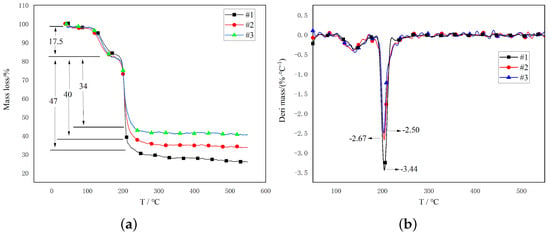
Figure 1.
TG −DTG curve of propellant samples. (a) TG curve of propellant samples. (b) DTG curve of propellant samples.
Figure 1 shows that the TG−DTG curves of the three propellant samples are similar, all showing three mass loss stages. The first mass loss stage occurs between 110 and 200 °C, with all three samples losing about 17.5% of their mass. The mass loss is mainly due to the volatilization and thermal decomposition of NGy and DIANP [20]. The second mass loss stage happens between 200 and 240 °C. The mass loss rates were 47%, 40%, and 34%, respectively, as the TAHT content increased. The third mass loss stage occurs between 240 and 500 °C, with a gradual weight loss of around 5%.
When TAHT is added to the nitroguanidine propellant, the mass loss process changes significantly compared to the original sample. It mainly affects the mass loss process in the second stage, reducing the maximum mass loss rate by 27%. However, it has little effect on mass loss in the first and third stages. In addition, the amount of final decomposition residue of the propellant sample also increased to a certain extent.
3.2.2. DSC Thermal Decomposition Characteristics of Propellants
The DSC curves of the three propellant samples at a heating rate of 10 °C·min−1 are shown in Figure 2. The curves shown in Figure 2 show that the shape of the peaks for all three propellants is the same within the tested temperature range. The thermal decomposition process is a single exothermic process, and each has only one central exothermic peak. The peak temperatures are 191.98 °C, 194.85 °C, and 195.04 °C, which increase with the amount of TAHT. At the same heating rate, the propellant with TAHT has a higher peak temperature than the NGu propellant (sample #1). As the TAHT content increases, the thermal decomposition peak temperature also increases.
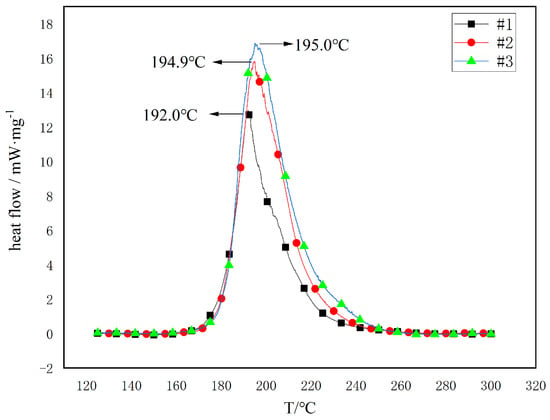
Figure 2.
DSC curves of three propellant samples at at the heating rate of 10 °C·min−1.
The thermal decomposition peak temperatures (Tp) of three samples of propellant #1, #2, and #3 at different heating rates (5.0, 10.0, 15.0, and 20.0 °C·min−1) are shown in Table 3. As shown in Table 3, all samples’ peak temperature (Tp) tends to increase with the heating rate. The increase in peak temperature indicates that the heating rate significantly affects the pyrolysis process. After adding TAHT, the Tp values of samples #2 and #3 are significantly higher than those of the original sample (sample #1), especially for sample #3. The peak temperature of the propellant samples shows higher values at all heating rates. The higher peak temperature indicates that adding TAHT improves the thermal stability of the samples and delays thermal decomposition.

Table 3.
Peak temperatures of three propellant samples at different heating rates.
3.2.3. Kinetics of Thermal Breakdown in Propellants
Activation energy represents the minimum energy required for a chemical reaction. The apparent activation energy of an energetic material is an important indicator of the ease of the decomposition process and is crucial for analyzing thermal decomposition performance. To study the effect of the nitrogen-rich material TAHT on the thermal decomposition performance of NGu propellant, the thermal decomposition kinetics of the three propellant samples were analyzed using DSC thermal decomposition curves. The Kissinger [21] and Ozawa [22] methods were used to calculate the kinetic parameters of the thermal decomposition reaction.
The following equation determines the Kissinger method:
where — the heating rate, K·min−1;
Tp — the peak temperature of thermal decomposition as measured by DSC, K;
Ea — the apparent activation energy, kJ·mol−1;
A — the pre-exponential factor, min−1;
R — the molar gas constant, R = 8.314 J·mol−1·K−1.
Perform a linear fit to the relationship and calculate the apparent activation energy (Ea) of each emulsion explosive sample from the slope of the line, respectively. The correlation coefficient should be at least 0.97.
The formula for determining the Ozawa method is as follows:
where ;
is the integral form of the reaction mechanism function, and the other terms follow the Kissinger method.
Perform a linear fit to the relationship and calculate the apparent activation energy (Ea) of each emulsion explosive sample from the slope of the line, respectively. The correlation coefficient should be at least 0.97.
According to Table 3, the thermal decomposition peak temperatures of three propellant samples (#1, #2, and #3) at different heating rates were obtained from the DSC curves. Then, linear fits are performed for and using the Kissinger and Ozawa methods. The kinetic parameters, such as the apparent activation energy (Ea) and the pre-exponential factor (A) of each propellant sample, were calculated from the slopes of the straight lines. The calculation results are shown in Table 4. As shown in Table 4, for the same sample, the apparent activation energy Ea obtained by the Kissinger and the Ozawa methods are similar, and the linear correlation coefficients r are close to 1. Compared with sample #1, the apparent activation energy Ea of propellant samples #2 and #3 containing TAHT is lower, with a decrease of 9.41% and 12.16%, respectively. As the content of TAHT increases, the apparent activation energy of the thermal decomposition of the propellant gradually decreases. The activation energy of the reaction is the temperature coefficient of the reaction. It shows that TAHT can increase the decomposition reaction rate of NGu propellant at lower temperatures while having a minor relative impact at higher temperatures due to the abundance of thermal energy. Therefore, it can be concluded that adding TAHT to the propellant reduces the temperature coefficient of the reaction rate, reducing its temperature sensitivity.

Table 4.
Thermal decomposition kinetic parameters of three propellant samples.
The values in Table 4 were calculated and plotted using the Arrhenius equation:
where k is the reaction rate; A is the pre-exponential factor; R is the kinetic constant; T is the thermodynamic temperature. The Arrhenius plot of k versus 1/T is shown in Figure 3.
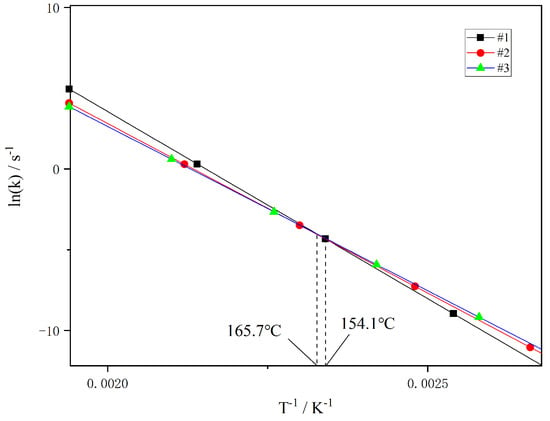
Figure 3.
Arrhenius curves of three propellant samples.
As can be seen from Figure 3, the three Arrhenius lines of the three types of propellant are plotted. The intersection point of the three lines is the isokinetic point of the two propellant samples, and the corresponding temperature is the isokinetic temperature. The isokinetic temperatures of sample #1 and sample #2 are 154.1 °C; the isokinetic temperatures of sample #1 and sample #3 are 156.6 °C; and the isokinetic temperatures of sample 2#2 and sample #3 are 165.7 °C. When the temperature is below 154.1 °C, the decomposition reaction rate of the propellant is sample #3 > sample #2 > sample #1; when the temperature is above 165.7 °C, the decomposition reaction rate of the propellant is sample #1 > sample #2 > sample #3. The addition of TAHT decreases the constant decomposition reaction rate of the NGu propellant at high temperatures. However, the peak temperature of the propellant measured by DSC is higher than its isothermal point. Therefore, the thermal decomposition peak temperature increases with increasing TAHT content.
As the TAHT content in the propellant samples increases, the apparent activation energy of the propellant gradually decreases. This reduction results in a lower reaction rate constant at temperatures above the isokinetic point. Given that the decomposition peak temperature measured by DSC (>200 °C) is significantly higher than all isokinetic temperatures, the decrease in the reaction rate at higher temperatures directly manifests as a delayed thermal decomposition peak. A higher TAHT content leads to a more significant reduction in activation energy, resulting in a more pronounced increase in the decomposition peak temperature. However, since the reaction rate is already high at elevated temperatures, the effect of TAHT on increasing the decomposition peak temperature becomes relatively limited.
3.3. Thermal Decomposition Characteristics of Pure TAHT
3.3.1. Differential Scanning Calorimetry (DSC) Analysis
The molecular formula of NGu is CH4N4O2. A conjugation effect exists between the carbon atom and the three nitrogen atoms in the molecule, forming a stable structure with the carbon atom at the center. There are also a large number of hydrogen bonds within the NGu molecule. These structural features further enhance the thermal stability of NGu [23]. The density of NGu is 1.77 g·cm−3, the nitrogen content is 53.8%, and the enthalpy of formation is −879.2 kJ·mol−1. Due to its high nitrogen content and stable structure, NGu can provide high energy release and good performance when used as the core component of the propellant.
In contrast, the molecular formula of TAHT is C6H2N18. Its density is 1.75 g·cm−3. Its nitrogen content is as high as 77.3%, which is much higher than traditional propellants. The enthalpy of formation is 1753 kJ·mol−1 [24]. The azide group (-N3) in the TAHT molecule has a high energy density, allowing it to release much energy during combustion or pyrolysis. At the same time, the high nitrogen content and unique structure of TAHT also give it advantages in terms of thermal stability and energy release efficiency. Therefore, it has become a high-energy additive with great potential. The addition of TAHT to the propellant is expected to increase the energy density and improve the combustion performance. It also has good environmental performance.
DSC tests were performed on two single materials, NGu and TAHT, at a heating rate of 10 °C·min−1. The results are shown in Figure 4.
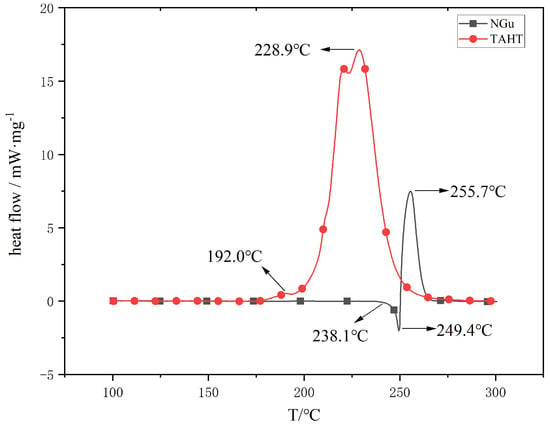
Figure 4.
DSC curves of two elemental energetic materials, NGu and TAHT, at the heating rate of 10 °C·min−1.
The DSC curve in Figure 4 shows that NGu begins to undergo endothermic melting at around 238.1 °C. There is a strong endothermic melting peak at around 249.4 °C, followed by a strong exothermic peak with a peak value of 255.7 °C. In contrast, TAHT starts thermally decomposing around 192.0 °C, with a peak of 228.9 °C.
NGu is known as a “melt-decomposition” type compound, where the melting process overlaps with its exothermic decomposition. As a result, the exothermic peak appears incomplete in the DSC curve. Therefore, the DSC signal observed in this work reflects only part of the decomposition behavior of NGu.
3.3.2. Analysis of Pyrolysis Gas-Phase Products
The gas-phase decomposition products of TAHT were analyzed using TG-MS-FTIR. The results are shown in Figure 5.
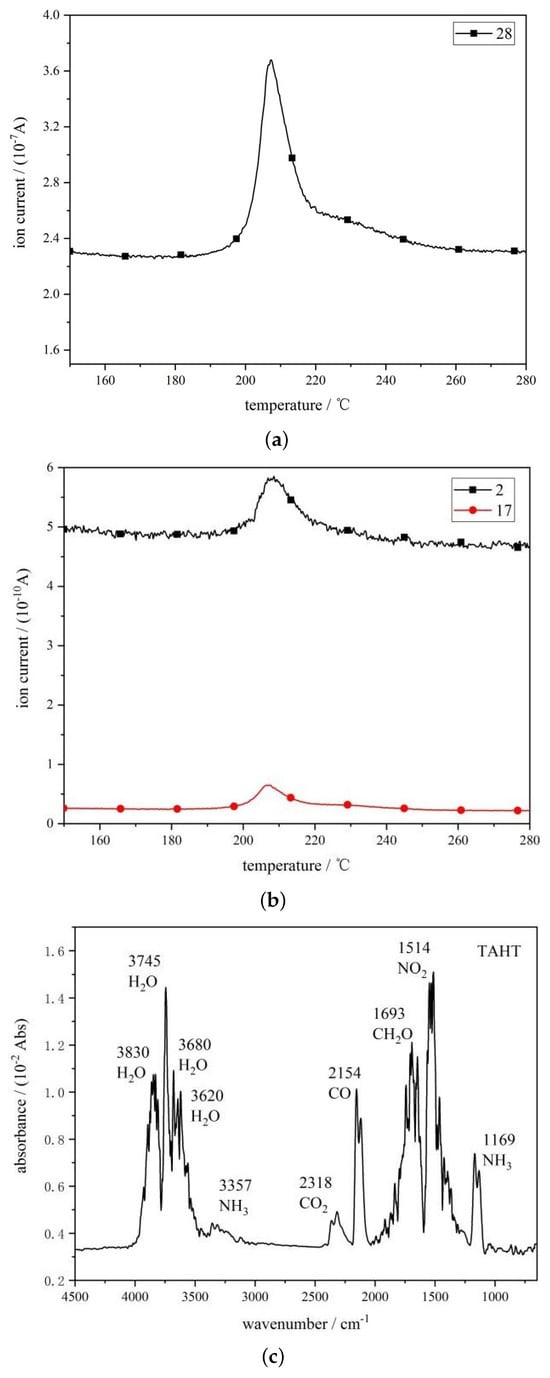
Figure 5.
Ion current intensities and FTIR spectra at peak temperature of the gaseous products of TAHT thermal decomposition. (a) Strong ion current. (b) Weak ion current. (c) FTIR spectra.
Figure 5a,b show the mass-to-charge ratio (m/z) signals of the gas-phase products during the thermal decomposition of TAHT. The results show that in the 190–250 °C range, a strong m/z = 28 signal occurs, accompanied by relatively weak m/z = 2 and m/z = 17 signals. Based on the known information, it can be hypothesized that m/z = 2 corresponds to H2, m/z = 17 corresponds to NH3, and m/z = 28 may originate from N2 or CO.
Figure 5c shows the infrared spectra of the gas-phase product of TAHT at the peak temperature of thermal decomposition under a heating rate of 10 °C/min. The spectral data show that the thermal decomposition products of TAHT have prominent absorption peaks at 3830, 3745, 3680, 3620, 3357, 2318, 2154, 1693, 1514, and 1169 cm−1. These absorption peaks suggest that the thermal decomposition of TAHT may produce H2O (3500–4000 cm−1), NH3 (3357, 1169 cm−1), CO2 (2318 cm−1), CO (ca. 2154 cm−1), NO2 (1514 cm−1), and CH2O (1693 cm−1). However, these results may be affected by the recombination of H, C, N, and O atoms after the ionization of the product molecules.
Further analysis of the mass spectrometry and infrared spectroscopy data showed that the signal intensity of m/z = 28 was much higher than that of H2 and NH3. In contrast, the intensity of the absorption peaks of CO was not significantly higher than that of NH3 in the infrared spectra. Since the N2 molecule has a highly symmetric linear structure, its symmetric vibration does not cause dipole moment changes and, therefore, does not produce IR absorption peaks. This lack of IR absorption suggests that the mass spectral signal at m/z = 28 is mainly from N2 rather than CO. Therefore, it can be inferred that the primary thermal decomposition gas product of TAHT is N2.
The TAHT structure contains four azide groups, which can cross-link with each other by releasing nitrogen gas during thermal decomposition. The triazine ring and the azide group are also essentially coplanar. Therefore, during the rearrangement of the cross-linking, it continues to expand in a laminar manner under the influence of external energy, such as heat. It is speculated that by combining the reported thermal decomposition mechanisms of similar nitrogen-rich compounds, including triazoles, tetrazoles, tetrazines, and furans [9,25,26] the -NH-NH- in the molecules of TAHT may split the azo triazine ring into many individual triazine rings by forming H2 and N2 after thermal decomposition. These triazine rings then cross-link with each other to form a new network structure, with the N remaining after the H2 and N2 have been removed from the -NH-NH- group, serving as the bridgehead atom. The result is the formation of aziridine polymers. Therefore, the proposed pyrolysis mechanism is shown in Figure 6.
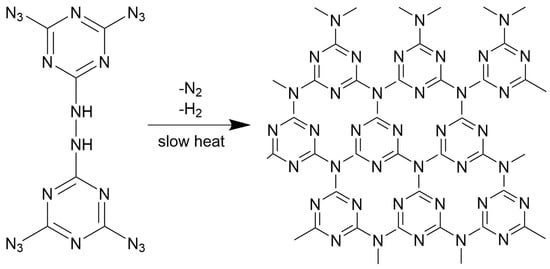
Figure 6.
The possible pyrolysis mechanism of TAHT.
When TAHT is added to the propellant as a high-energy additive, it produces highly stable residue-like substances during thermal decomposition. These residues can quickly accumulate on the propellant’s surface, blocking the mass transfer from the condensed phase to the gas phase and affecting heat transfer from the gas phase to the condensed phase.
4. Conclusions
In this experiment, different propellant formulations with different TAHT contents were designed. Differential scanning calorimetry and thermogravimetry–mass spectrometry–infrared triple technology were used to test its thermal decomposition performance at different heating rates. The Kissinger method and Ozawa method were also used. The effect of adding TAHT on the propellant’s thermal decomposition performance was studied using the above methods. The conclusions are as follows:
- Thermogravimetric analysis indicated that adding TAHT to the nitroguanidine propellant can significantly reduce the mass loss rate of the propellant. When the TAHT content is 20%, the maximum mass loss rate is reduced by 27%.
- The DSC analysis shows that adding TAHT to the propellant raises the peak temperature of thermal decomposition. However, the apparent activation energy decreases. The activation energies for the three propellant samples were calculated using the Kissinger and Ozawa methods. The Kissinger method showed a decrease in activation energy from 192.8 kJ·mol−1 to 174.7 kJ·mol−1 and 169.4 kJ·mol−1, while the Ozawa method revealed a drop from 190.7 kJ·mol−1 to 173.5 kJ·mol−1 and 168.5 kJ·mol−1. The activation energies were reduced by about 9% and 12%, respectively. The isothermal decomposition temperatures for the three samples were 154.1 °C, 156.6 °C, and 165.7 °C. The addition of TAHT decreased the decomposition reaction rate constant of NGu propellant at high temperatures.
- The FTIR test results of TAHT show that a highly thermally stable azopolymer is formed during its thermal decomposition. This azopolymer accumulates instantaneously on the surface of the propellant, thereby preventing mass transfer from the condensed phase to the gas phase and affecting heat transfer from the gas phase to the condensed phase. Therefore, after being added to the propellant, TAHT has the potential to inhibit thermal decomposition and reduce temperature sensitivity.
Author Contributions
Y.X.: conceptualization, methodology, investigation, writing—original draft. J.Y.: resources, validation, formal analysis, writing—review and editing. R.W.: investigation, data curation, writing—review and editing. Y.G.: investigation, data curation. W.Y.: writing—review and editing. D.W.: validation, formal analysis. Y.Z.: supervision, project administration. All authors have read and agreed to the published version of the manuscript.
Funding
This research received no external funding.
Data Availability Statement
The data supporting the reported results in this study are not publicly available due to privacy restrictions.
DURC Statement
The current research is limited to the field of energetic materials. It focuses on investigating the thermal decomposition behavior of TAHT from a thermodynamic perspective, aiming to provide theoretical support for its potential application. It does not pose a threat to public health or national security. The authors acknowledge the dual-use potential of research involving energetic compounds and confirm that all necessary precautions have been taken to prevent potential misuse. As an ethical responsibility, the authors strictly adhere to relevant national and international regulations regarding DURC. The authors advocate for responsible application, ethical considerations, regulatory compliance, and transparent reporting to minimize misuse risks and promote beneficial outcomes.
Conflicts of Interest
The authors declare no conflicts of interest.
Abbreviations
The following abbreviations are used in this manuscript:
| DIANP | Azidonitramine |
| DSC | Differential Scanning Calorimetry |
| DTG | Derivative Thermogravimetry |
| FTIR | Fourier Transform Infrared Spectroscopy |
| IR | Infrared Spectroscopy |
| MS | Mass Spectrometry |
| NC | Nitrocellulose |
| NGu | Nitroguanidine |
| NGy | Nitroglycerin |
| TAHT | 4,4′,6,6′-Tetraazido-1,3,5-Triazine |
| TATDO | 2,4,6-Triamino-1,3,5-Triazine-1,3-Dioxid |
| TG | Thermogravimetric Analysis |
References
- Yu, Q.; Singh, J.; Staples, R.J.; Shreeve, J.N. Assembling nitrogen-rich, thermally stable, and insensitive energetic materials by polycyclization. Chem. Eng. J. 2022, 431, 133235. [Google Scholar] [CrossRef]
- Luo, Y.; Zheng, W.; Wang, X.; Shen, F. Nitrification progress of nitrogen-rich heterocyclic energetic compounds: A review. Molecules 2022, 27, 1465. [Google Scholar] [CrossRef] [PubMed]
- Cao, Y.; Lai, W.; Yu, T.; Liu, Y.; Wang, B. Can N-oxidation alleviate the energy-safety contradiction of energetic materials. FirePhysChem 2021, 1, 27–32. [Google Scholar] [CrossRef]
- Liu, Y.; Dong, Z.; Yang, R.; Li, H.; Liu, Y.; Ye, Z. Imino-bridged N-rich energetic materials: C4H3N17 and their derivatives assembled from the powerful combination of four tetrazoles. CrystEngComm 2021, 23, 5377–5384. [Google Scholar] [CrossRef]
- Zhang, X.G. Study on Synthesis and Thermal Decomposition of High-Nitrogen Compounds and Their Energetic Materials. Ph.D. Thesis, National University of Defense Technology, Changsha, China, 2005. [Google Scholar]
- Luo, Y.F.; Ge, Z.X.; Wang, B.Z.; Zhang, H.-H.; Xiong, C.-L. Synthesis and Characterization of 1H,4H-3,6-Dinitro-pyrazole[4,3-c]pyrazole Amine Salt. J. Propellants Explos. Pyrotech. 2008, 31, 98–101. [Google Scholar]
- Zhao, W.X.; Jiang, H.B.; Wang, H.S. Synthesis and Thermal Analysis of of nickel(II) complex of 5-Aminotetrazole. Appl. Chem. Ind. 2011, 40, 1868–1870. [Google Scholar]
- Yin, X. Synthesis and Properties of N-Trinitromethyl-1,2,3-Triazole Compounds. Ph.D. Thesis, Southwest University of Science and Technology, Mianyang, China, 2015. [Google Scholar]
- Huynh, M.H.; Hiskey, M.A.; Hartline, E.L.; Montoya, D.P.; Gilardi, R. Polyazido high-nitrogen compounds: Hydrazo- and azo-1,3,5-triazine. Angew. Chem. Int. Ed. 2004, 43, 4924–4928. [Google Scholar] [CrossRef] [PubMed]
- Huynh, M.H.; Hiskey, M.A.; Archuleta, J.G.; Roemer, E.L.; Gilardi, R. 3,6-di(azido)-1,2,4,5-tetrazine: A precursor for the preparation of carbon nanospheres and nitrogen-rich carbon nitrides. Angew. Chem. Int. Ed. 2004, 116, 5776–5779. [Google Scholar] [CrossRef]
- Ali, A.N.; Son, S.F.; Hiskey, M.A.; Naud, D.L. Novel high nitrogen propellant use in solid fuel micropropulsion. J. Propuls. Power. 2004, 20, 120–126. [Google Scholar] [CrossRef]
- Klapötke, T.M.; Mayer, P.; Stierstorfer, J.; Weig, J.J. Bistetrazolylamines—Synthesis and characterization. J. Mater. Chem. 2008, 18, 5248–5258. [Google Scholar] [CrossRef]
- Myers, T.W.; Bjorgaard, J.A.; Brown, K.E.; Chavez, D.E.; Hanson, S.K.; Scharff, R.J.; Tretiak, S.; Veauthier, J.M. Energetic chromophores: Low-energy laser initiation in explosive Fe(II) tetrazine complexes. J. Am. Chem. Soc. 2016, 138, 4685–4692. [Google Scholar] [CrossRef] [PubMed]
- Chen, S.H.; Wan, C.; Feng, Z.C.; Chapyshev, S.V.; Chukanov, N.V.; Yuantsze, S. Thermal Decomposition Characteristics of 2,4,6-Triamino-1,3,5-Triazine-1,3-Dioxide (TATDO). Chin. J. Explos. Propellants 2023, 46, 748–754. [Google Scholar]
- Cai, M. Synthesis, Characterization, and Properties of Five Triazine-Based Energetic Compounds. Ph.D. Thesis, Northwest University, Xi’an, China, 2021. [Google Scholar]
- Chen, X. Synthesis and Properties of Asymmetric Tetrazine-Based Energetic Compounds. Ph.D. Thesis, Northwest University, Xi’an, China, 2018. [Google Scholar]
- Jia, L.; Lu, H.L.; Han, F. Influence of Azidonitramine on the Thermal Behavior of the Nitroguanidine-Based Gun Propellant. Chin. J. Explos. Propellants 2015, 38, 90–93. [Google Scholar]
- GJB 772A-97; Explosive Test Methods. General Armaments Department: Beijing, China, 1997.
- WJ/T 9052.2-2006; Test Methods for Gunpowder and Pyrotechnics—Part 2: Thermal Analysis Method. Commission of Science, Technology and Industry for National Defense, China National Institute of Standardization of Military Industry: Beijing, China, 2006.
- Xie, D.F.; Huang, Z.Y.; Song, Y.P.; Zhang, C. Effect of Ethylenediamine Triethylenediamine Perchlorate on Thermal Decomposition Reaction of High Energy Gun Propellant. Chin. J. Explos. Propellants 2020, 43, 208–212. [Google Scholar]
- Kissinger, H.E. Reaction kinetics in differential thermal analysis. Anal. Chem. 1957, 29, 1702–1706. [Google Scholar] [CrossRef]
- Ozawa, T. A new method of analyzing thermogravimetric data. Bull. Chem. Soc. Jpn. 1965, 38, 1881–1886. [Google Scholar] [CrossRef]
- Stoner, C.E.; Brill, T.B. Thermal Decomposition of Energetic Materials 46. The Formation of Melamin-like Cyclic Azines as a Mechanism for Ballistic Modification of Composite Propellants by DCD, DAG, and DAF. Combust. Flame 1991, 83, 302–308. [Google Scholar] [CrossRef]
- Li, Y.C.; Zhang, X.J.; Fu, G.; Pang, S.; Zhao, C. Synthesis, Characterization, and Thermal Decomposition Study of 4,4′,6,6′-Tetraazido-Azo-1,3,5-Triazine (TAAT). J. Org. Chem. 2011, 31, 1484–1489. [Google Scholar]
- Steinhauser, G.; Klapötke, T.M. “Green” pyrotechnics: A chemists’ challenge. Angew. Chem. Int. Ed. 2008, 47, 3330–3347. [Google Scholar] [CrossRef]
- Oxley, J.C.; Smith, J.L.; Moran, J.S. Decomposition of Azo- and Hydrazo-Linked Bis Triazines. J. Energetic Mater. 2009, 27, 63–93. [Google Scholar] [CrossRef]
Disclaimer/Publisher’s Note: The statements, opinions and data contained in all publications are solely those of the individual author(s) and contributor(s) and not of MDPI and/or the editor(s). MDPI and/or the editor(s) disclaim responsibility for any injury to people or property resulting from any ideas, methods, instructions or products referred to in the content. |
© 2025 by the authors. Licensee MDPI, Basel, Switzerland. This article is an open access article distributed under the terms and conditions of the Creative Commons Attribution (CC BY) license (https://creativecommons.org/licenses/by/4.0/).